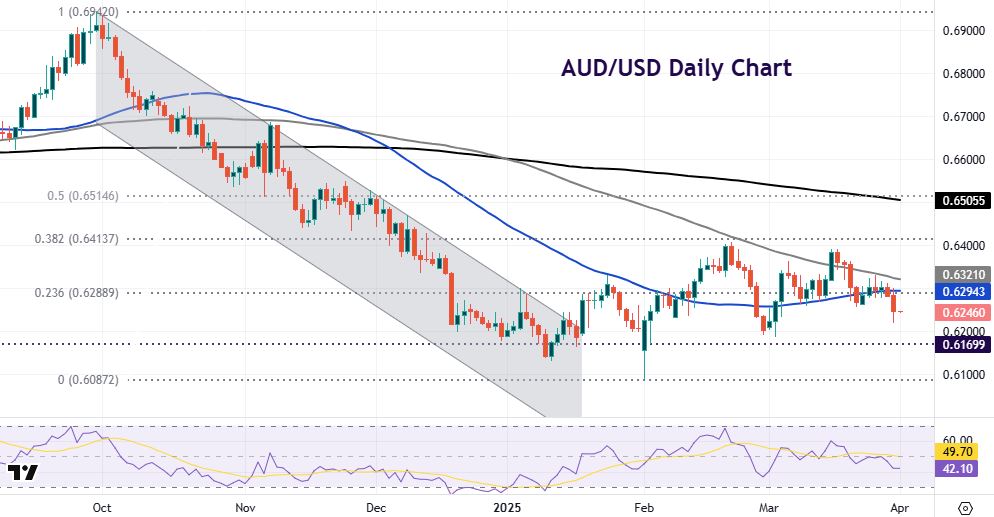Quarter end sees choppy markets ahead of Liberation Day

- Dollar gains and gold posts a record high on tariff concerns
- Stocks closed mixed on the day, post big quarterly % drop
- More ECB officials appear ready to accept an April rate pause
- Trump to announce ‘country-based’ tariffs on Wednesday; China, Japan, South Korea to jointly respond to US
FX: USD bounced back from early losses to post modest gains in a choppy day of trade. President Trump is said to be pushing senior advisers to go bigger on tariff policy and reportedly revived the idea of a flat universal tariff single rate on most imports. Hitting the “dirty 15” % of countries, which are responsible for nearly 90% of the US goods trade deficit, as suggested the Treasury Secretary Bessent, also appears to be gaining favour.
EUR printed a doji candle denoting indecision, which is inevitable price action ahead of such a big day on Wednesday. The region’s inflation data is released today, though sentiment is the likely dominant driver of near price euro action.
GBP printed a similar intraday price pattern to the euro with a doji. Sterling is showing notable relative resilience in the current environment of trade-related risk aversion. The UK looks like it will be struck with tariffs, even though there were “productive” talks between PM Starmer and President Trump over the weekend.
USD/JPY dropped to al ow of 148.69 before printing in the green on the day in a rejection of lower prices. The yen had initially outperformed on safe haven demand before stocks turned around.
AUD struggled on the general muted risk mood though closed off its lows. USD/CAD popped higher towards 1.44 even though PM Carney and Trump had a positive weekend call. The former told provincial leaders that tariffs may come at the lower end of the scale and may not be applied broadly across the economy.
US stocks: The S&P 500 added 0.55% to settle at 5,612. The tech-heavy Nasdaq finished down 0.02% at 19,278. The Dow closed 1% higher at 42,02. Consumer staples and financials outperformed with only consumer discretionary in the red. Tech stocks in particular gapped lower on the open before rebounding through the session. The S&P 500 and Nasdaq posted the worst month since December 2022 and the biggest quarterly falls since late and mid-2022. The S&P 500 slumped 4.5% and the Nasdaq plunged 7.7%. Growth names sold off heavily with the Mag 7 leading the downside. Tesla was off nearly 36% in the Q1 and Nvidia tanked close to 20%. But a majority of the 11 S&P sectors were actually higher in the same period, led by energy’s 9.3% increase – the lesson was to diversify and avoid the dangers of market concentration.
Asian stocks: Futures are mixed.APAC stocks were heavily sold into month- and quarter-end amid tariff concerns. Geopolitical risks are hit stocks after US President Trump voiced anger towards Russian President Putin for comments about Ukrainian President Zelensky and Trump also threatened to bomb Iran if a nuclear deal can’t be reached.The ASX 200 dropped with all sectors in the red and underperformance in the mining, resources and materials sectors. The Nikkei 225 suffered heavy losses (-4.05%) and tumbled beneath the 36,000 level. There was notable weakness seen in tech stocks, while selling was exacerbated heading into fiscal year-end and amid yen strength. The Hang Seng and Shanghai Comp fell after early resilience seen in the mainland following encouraging Chinese PMI data and reports that China’s Finance Ministry is to inject USD 69bln into four large Chinese banks. There was also a slew of earnings releases including from big banks.
Gold surged higher to another all-time top at $3,127. Tariff uncertainty is pushing investors into safe havens and full-on risk-off mode.
Day Ahead – RBA Meeting, Eurozone inflation
Consensus fully expects the Reserve Bank of Australia to hold its cash rate steady at 4.10%. The bank initiated its rate cutting cycle at the previous meeting but did not pre-commit to delivering further easing. Recent rhetoric from policymakers since the last meeting has pointe to a lack of urgency for a back-to-back rate move. The key CPI trimmed mean metric is still hot at 2.7%, especially with tariffs looming. Markets currently price in two to three cuts for the rest of 2025.
Expectations are for March eurozone inflation to hold steady at 2.3% whilst the core is set to ease one-tenth to 2.5%. There was a pullback in services inflation to 3.7% from 3.9% in February. For the upcoming report, energy prices should again record a monthly fall while food and goods prices are likely to have ticked higher. However, given the recent declines in services inflation, rate setters are more focused on evidence of further signs that inflation is on a sustainable path to target. Money markets, which pared bets on ECB rate cuts in recent days, see around 58bps by year-end.
Chart of the Day – AUD breaking down?
The aussie has been in the crosshairs of a potentially deteriorating global trade environment in the last few weeks. In fact, it was barely in the green versus the dollar in March, as the worst performing major currency. A cautious message is predicted from the RBA, with plenty of focus on the tariff uncertainty and more softening in inflation needed for policy easing. Going forward, AUD may not see much support if US trade policy pushes the wider economy into a prolonged slowdown. A long-term low at 0.6169 from October 2022 is key support, with the January year-to-date spike trough at 0.6087. The 50-day SMA and a Fib level at 0.6288/93 may offer initial resistance.

